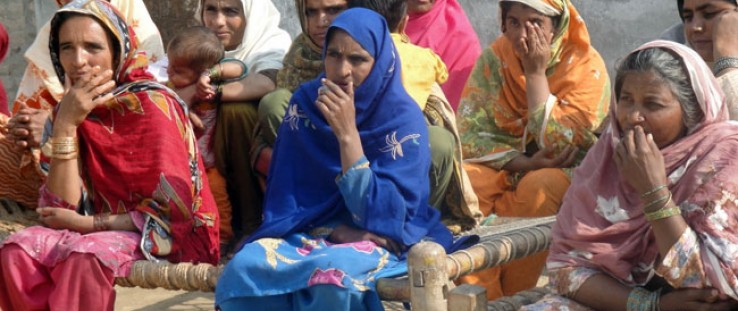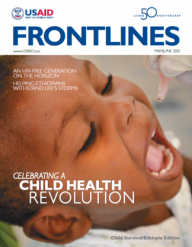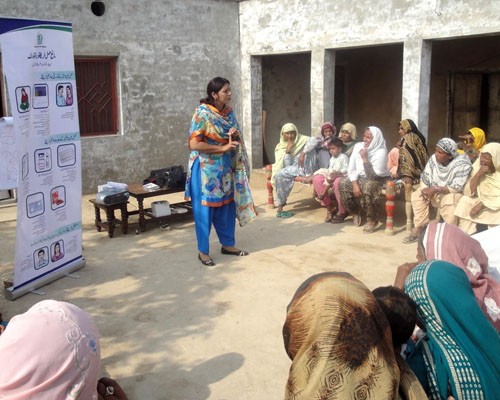 Women participate in a community mobilization activity conducted by USAID’s FALAH project.
Population Council
Women participate in a community mobilization activity conducted by USAID’s FALAH project.
Population Council
 Women participate in a community mobilization activity conducted by USAID’s FALAH project.
Population Council
Women participate in a community mobilization activity conducted by USAID’s FALAH project.
Population Council
Ranjeet Kumar and his wife Heemi were both just 16 when they married in 2009. They looked forward to beginning their journey together and starting a family, as other couples their age had done. In Pakistan, one out of six women between the ages of 15 and 19 is already married.
As the couple thought about having children, they also recognized the risks that came along with it. Maternal mortality is high in Pakistan—20 percent of all deaths of women ages 12 to 49 are a result of complications during pregnancy and childbirth.
“We were unable to understand the reasons of young maternal deaths in our village,” said Heemi.
A community health worker invited the couple to a session on the importance of birth spacing put on by USAID’s flagship family planning project in Pakistan, Family Advancement for Life and Health (FALAH).
“After attending a sensitization session on the importance of birth spacing, things became much more clear,” said Ranjeet, “so we jointly decided to delay our first pregnancy until Heemi turns 18.”
Babies born to young mothers under age 18 are more likely to be premature, have low birth weights, and suffer from delivery complications. Teen pregnancies pose health risks not only for the babies but also for young mothers. Compared to older women, girls in their teens are twice as likely to die from pregnancy and child birth-related causes and their babies also face a 50 percent higher risk of dying before age 1 than babies born to women in their 20s. In the developing world, an estimated 90 percent of infants whose mothers die in childbirth will die by their first birthday.
“Enabling couples to choose the timing and spacing of their children is vital to safe motherhood and child survival,” said Kate Crawford, director of USAID/Pakistan’s Population, Health and Nutrition Office.
Delaying and Spacing
USAID’s FALAH project, which ended in the spring of this year, sought to educate women, families, and community and religious leaders on the importance of waiting 24 months after a live birth before attempting a pregnancy to ensure the healthiest outcomes for mother and newborn. In 15 districts across Pakistan, the project informed families about a variety of available methods of family planning and increased access to quality family planning services in the public and private sectors. These 15 districts cover about 18 percent of Pakistan’s population of 186 million.
Launched in 2008, the project used community health workers and meetings to educate married women of reproductive age and their husbands on the importance of birth-spacing. FALAH efforts reached more than 9 million women and men through community mobilization activities, home visits, neighborhood meetings, interactive theater, and group meetings.
The project also raised awareness of pregnancy-related health risks among women under the age of 18 and older than 34, and among women who have more than three children. This approach is known as Healthy Timing and Spacing of Pregnancy (HTSP).
Delaying and spacing births helps women bear children during their healthiest years and enables them to have their desired number of children. Studies show children are more likely to die before the age of 5 if they were born less than three or more than five years after a sibling. Data from the latest Pakistan Demographic and Health Survey show that longer intervals between births cut in half the incidence of neonatal mortality when the birth-to-pregnancy interval is increased from less than 24 months to over 24 months.
“Global evidence has shown us that the healthiest interval between a woman’s previous pregnancy and a new one should be at least two years, and one-third of maternal deaths can be avoided through spacing,” said Dr. Zeba Sathar, the country director of the Population Council in Pakistan, the lead implementer of the FALAH project. “Babies born less than two years after their older sibling are twice more likely to die in the first year of birth than those born after an interval of three years.”
Shifting Paradigms
On average, a Pakistani woman gives birth to four children during her reproductive life; in rural areas that number is six. Although family planning activities started in the country in the early 1960s, contraceptive use has increased marginally in the past 22 years. The number of married women of reproductive age using modern contraception has stalled at around 22 percent. The FALAH project is helping create a paradigm shift in Pakistani perspectives of family planning. Previous family planning programs emphasized limiting the number of births, while the FALAH program focused on ensuring healthy mothers and families.
“In countries like Pakistan, there have existed many myths about family planning,” said Maureen Norton, USAID HTSP technical adviser. “The HTSP approach repositions family planning in a way that aligns with Pakistani religious and cultural beliefs that support pregnancy spacing for the health of the mother and child. In fact, FALAH worked closely with hundreds of religious leaders to help spread these messages.”
Using a “training of trainers” approach, the FALAH project trained more than 1,500 religious scholars, or ulemas, to become trainers about HTSP and reduce religious and cultural barriers to family planning, especially among men. Many of these religious leaders have become advocates of HTSP messages in their communities.
“After receiving the orientation from FALAH, we are now very clear that Islam allows birth spacing,” said Qari Mahmood Ahmad Qasmi, a religious leader in Rajanpur. “And now when we go in to the community, it becomes much easier for us to convince people as we ourselves are convinced. The community looks upon us as their role models and they follow what we tell them to.” The project’s community health worker programs, public-private partnerships and advocacy efforts have transformed people’s perception and mindset to view family planning as an important health intervention for the wellbeing of the mother, child and family, Norton said.
In the districts where the FALAH project worked, the number of married women using contraception increased by 8.5 percent on average, a remarkable achievement, with the uptake highest amongst poor, rural and younger couples. This has been possible to a great extent by involving men in the family planning discussion, through FALAH’s Information, Education and Communication initiatives, and by training providers to proactively provide services.
FALAH also developed television and radio messages that, when aired nationally, reached 50 million people, or about one-third of the population of the country. The key commercial depicted a happy couple with their newborn, and included a jingle on the importance of waiting two years between pregnancies. The spots also featured endorsements of leading health professionals on the benefits of birth spacing.
“The FALAH project is a strong example of the U.S. Government’s long-term commitment to support Pakistan in improving the health and welfare of its people,” said Karen Freeman, USAID/Pakistan’s deputy director.
USAID’s continued efforts to integrate family planning and maternal health services and to increase access to quality care in Pakistan will ensure couples like Ranjeet and Heemi will wait until their healthiest years to have children, so that more children will have a chance at a healthy start in life.










Comment
Make a general inquiry or suggest an improvement.